Rugs with material on the back
Most professional rug cleaners should know this, but in case you don’t…
… wool rugs with material on the back like this one, are called TUFTED rugs:
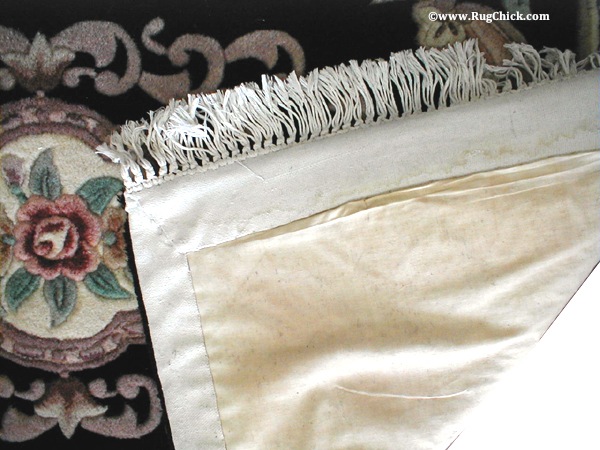
Tufted rug from China. Loose cotton material backing.
Some have a loosely attached material like the above one from China, and some have material that is more firmly in place like this one from India:
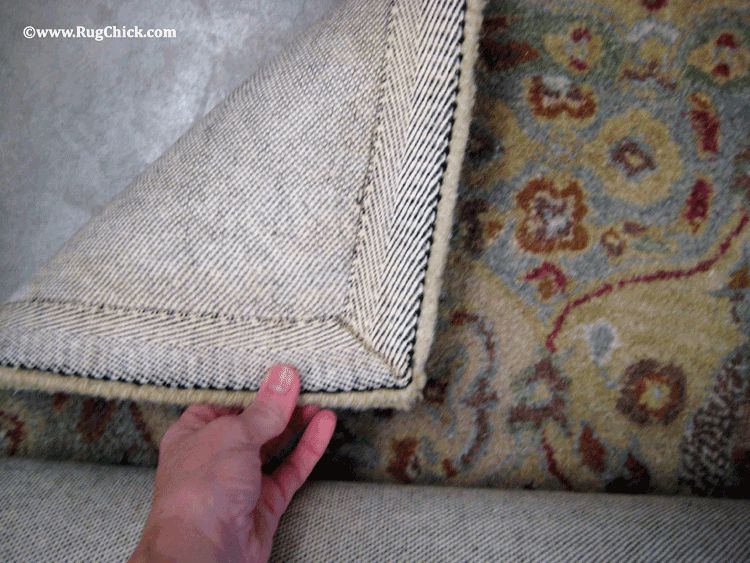
Tufted wool rug from India.
I call tufted rugs “fake rugs” because these are commodity rugs that are quickly constructed by punching tufts through a canvas backing, and covered in a great deal of latex adhesive to hold it together, and then they shear off the top loops so that it gives the illusion of a pile woven rug from the top side, when it’s not woven at all.
Woven rugs take months, sometimes years to weave. They are pieces of art.
Tufted rugs are a way to get the “look” of a real rug (to the untrained eye), at a fraction of the construction time and cost. Most are “commodity” rugs. These rugs take days to craft, as opposed to months, and they will last you several years of use as opposed to woven oriental rugs that often outlive several generations of owners.
So, as with anything where corners are being cut to create a faster, cheaper version, there are consequences. And especially consequences – and limitations – if you are cleaning these tufted rugs.
Regardless of the type of material on the back of tufted rugs, they are all covering up this ugly mess of latex on the back holding the tufts of wool in place:
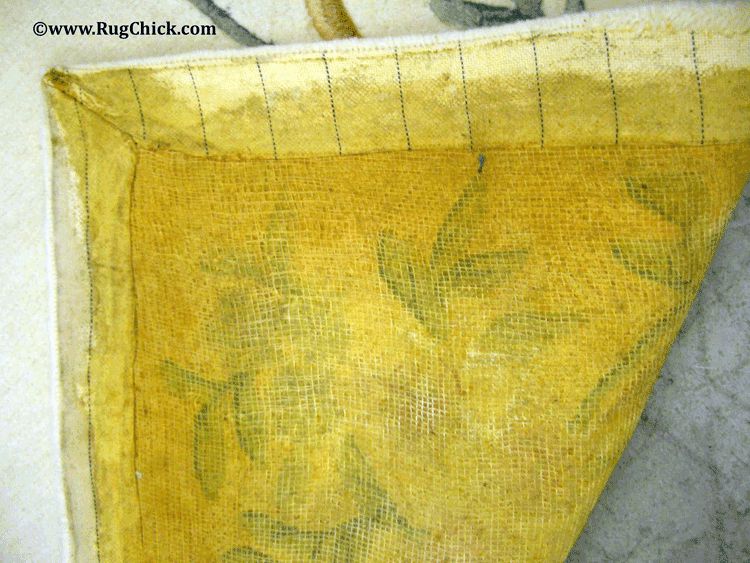
Latex backing of a tufted rug.
It is much prettier when covered up with material, don’t you think? =)
We mentioned the “plus” of tufted rugs, which is primarily that they are crafted faster and as a result are much cheaper to buy versus woven rugs.
(There are some high-price exceptions like Edward Fields hand crafted tufted rugs, which are much higher quality than what I’m showing here, but that is 1% of the tufted rug market, so I am talking about what you are seeing coming out of China, India, U.S., and other countries today.)
Let’s talk about some of the “consequences” of choosing a commodity tufted wool rug instead of a woven wool rug, so you are not surprised when any of these challenges come up.
BUCKLING
If you take a tufted rug and place it on a soft surface (like putting it on top of wall-to-wall carpeting) and then set heavy furniture over it, you will be in for a surprise.
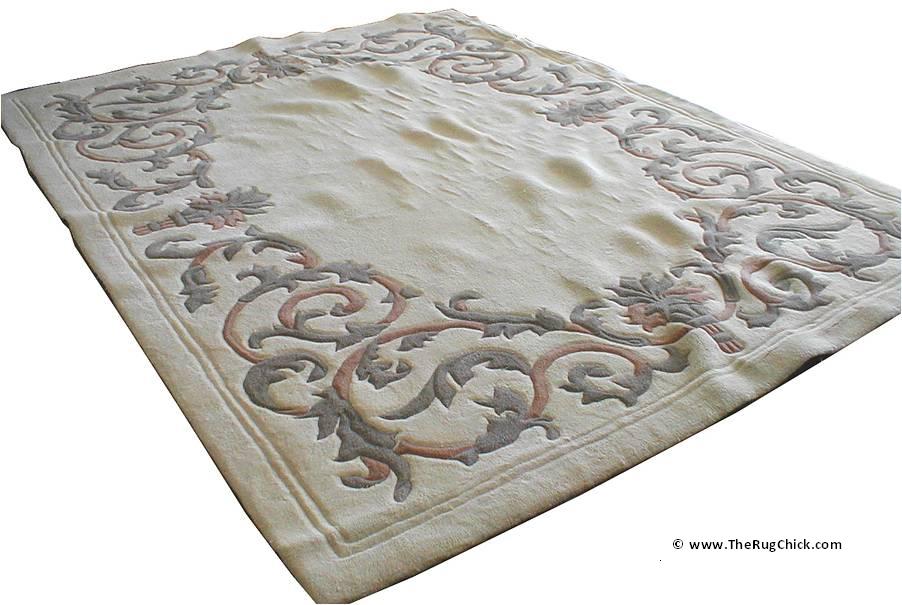
Tufted rug buckling from furniture.
Though a good amount of latex is used on the back of these rugs, it’s still susceptible to cracking when too much weight is focused on specific points. If there is not a durable pad under the rug to support the furniture, then these lumps in a rug like this may not be correctible.
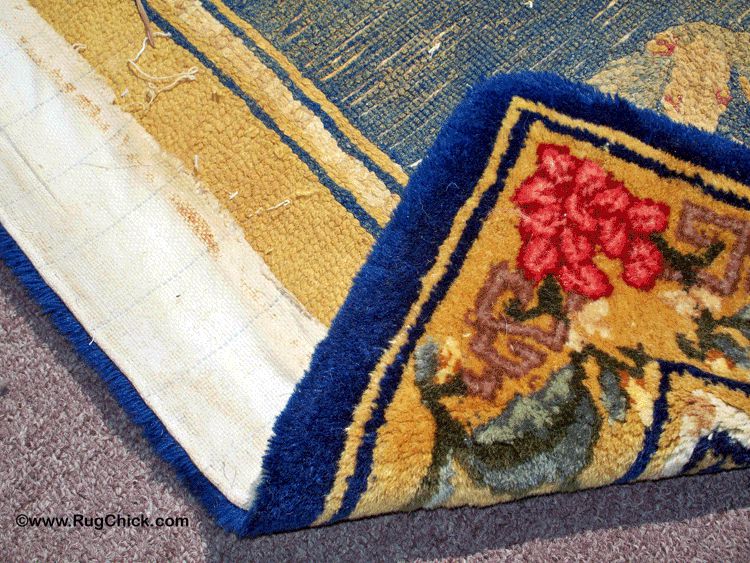
Back of Chinese tufted rug.
These rugs, to keep their shape, need to be on top of a hard surface when used. These face fibers are not twisted around warps like woven rugs are, but rather are looped in the shape of a “U” – so the only thing holding them in place is a thin dollop of glue. Take a look at these fibers falling away from this torn corner of a tufted rug:
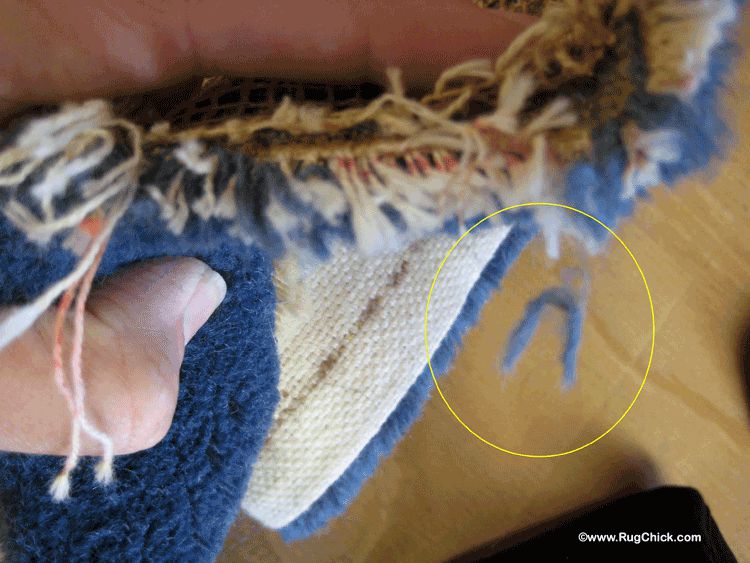
Tufts falling away from a damaged corner.
There really is not much there to hold those “U” fibers in place. In fact, even with brand new tufted rugs, if you grab one fiber and tug, you will be able to pull it out.
Because of this latex construction, you want to take care on what you place on top of it, even if the rug is brand new, because it can’t take too much weight and bending.
DELAMINATION
Over time latex will degrade and deteriorate. In the past this meant a bit of crumbling and cracking, but in some of today’s tufted rugs, delamination is a MUCH messier situation:
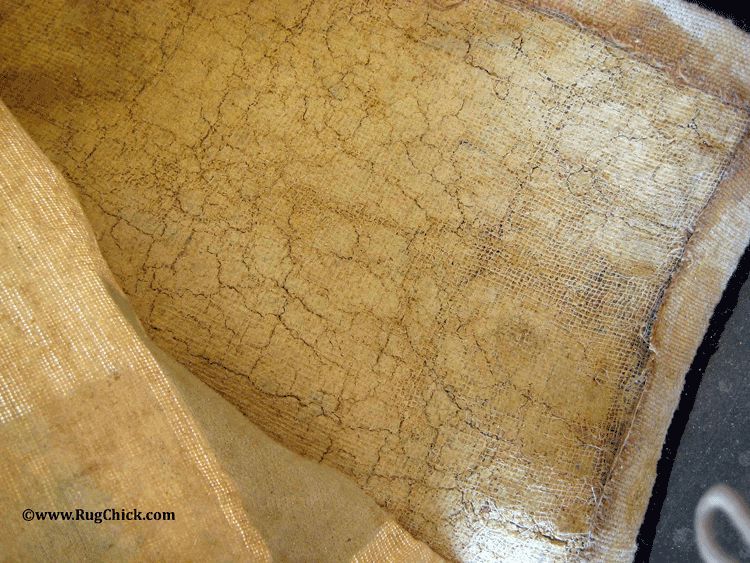
Backing deterioration from water exposure and inferior quality latex.
Some of the lesser quality tufted rugs, in particular some coming from India today (and also some US hooked rugs), are using latex mixed with “filler” to help extend the batch of the adhesive and also to provide a firmer application to give the rug some shape.
This filler is sometimes marble dust, and sometimes concrete. But it is always a MESS when it gets wet.
This is by far the biggest danger facing rug cleaners today in handling tufted rugs, is the fact that some of these rugs cannot be soaked without having to deal with a big ugly mess. The rug not only cracks, crumbles, and powders all across the back and often “poofing” up through the front also…
…but it also leads to the rug losing its shape, because it was that heavy latex and filler that was making the rug stiff and square in the first place:
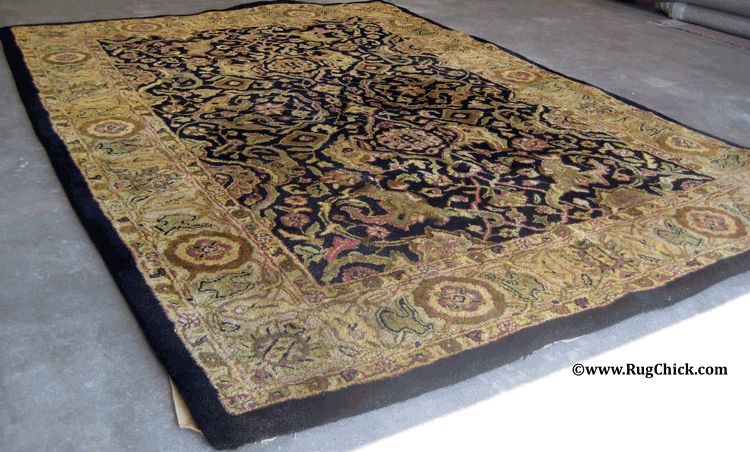
Tufted rug lost its shape after the latex deteriorated from a flood.
If you need to wash the rug (because it’s quite dirty), pull off the material on a corner and see if you might be unleashing a disaster with getting the rug wet.
BACKING DISCOLORATION
What do you think happens when you have an ugly, messy latex application, and then place a nice clean cotton material backing over the top?
At first, it looks great. Then, over time it begins to yellow (wouldn’t you if you were laying up against glue 24/7?)…
…and then when you wash it, and the glue residue, soil, dyes, and other “unmentionables” go through that cotton, like a filter – what do you think that does to the cotton? Well, I’ll show you:
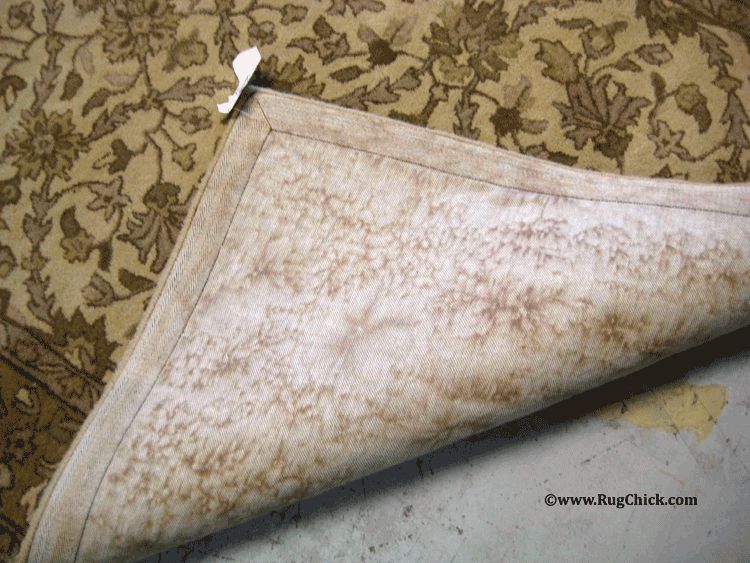
Water marks, dye marks, browning marks on the back of a clean tufted rug.
One of the unfortunate consequences of owning a tufted rug is that when it gets washed, that backing gets marks all over it.
If the tufted rug is not heavily soiled, then a cleaner may opt to surface clean it as best as he can, and not mark up the backing, but in most cases rugs that come in for cleaning need a good wash. And soaking these rugs, which gets them the cleanest, will change the look of the backing material.
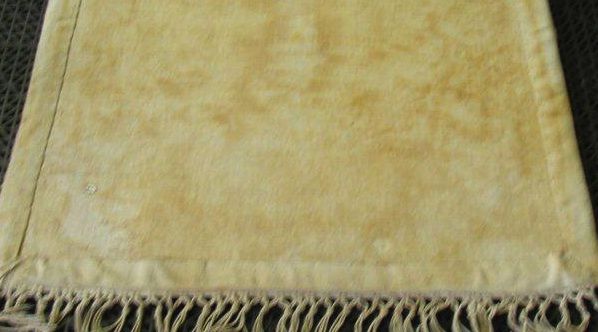
Water marks and browning on backing material.
Some of these marks can be improved with additional cleaning on the back side with an upholstery tool, to try to remove some of the browning on the cotton material. It adds additional cleaning time, and cost for this, but many people often do not care what the back side of their rug looks like, as long as the top side is nice and clean.
If the additional cleaning time does not improve the backing enough for the owner, it is also an option to pay to replace the material backing with a new piece (sometimes that is easier than trying to carefully clean the back and strip out those discolorations).
STENCIL INK BLEED
Another problem that is sometimes uncovered in the lesser quality hand-tufted rugs is the use of stenciling ink (usually pink or blue) to mark where tufts are places, and this ink can wick out and bleed when wet.
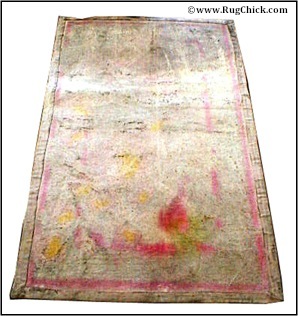
Back of tufted rug – stencil ink bled into backing material.
If you are not careful when cleaning rugs with this type of manufacturing flaw, then washing the rug can wick that ink to the top side of the rug’s fibers, and create large ink stains, which can be difficult to remove.
It’s important to look for “clues” on the back side that indicate stenciling marks were used. You can also grin the front fibers and look for anything noticeable from the front side.
Stenciling can be a messy problem. If you see the ink in your inspection process, and it is heavy, and bleeds in your dye test, then you may opt to only surface clean the rug.
It’s not the most thorough cleaning process to surface clean it, but it will be the only safe option for you in that case, especially if you are not equipped with the right type of equipment to quickly remove the water from the tufted rug and dry it quickly.
DECONTAMINATION CHALLENGES
Decontaminating tufted rugs to remove pet urine odor, or to decontaminate from flood exposure, can be tough.
Repeated pet urine contamination on a tufted rug can be next to impossible to remove the stink. Think about it… urine penetrating heavy glue. Do you really think a quick cleaning can get the contaminants out of that adhesive?
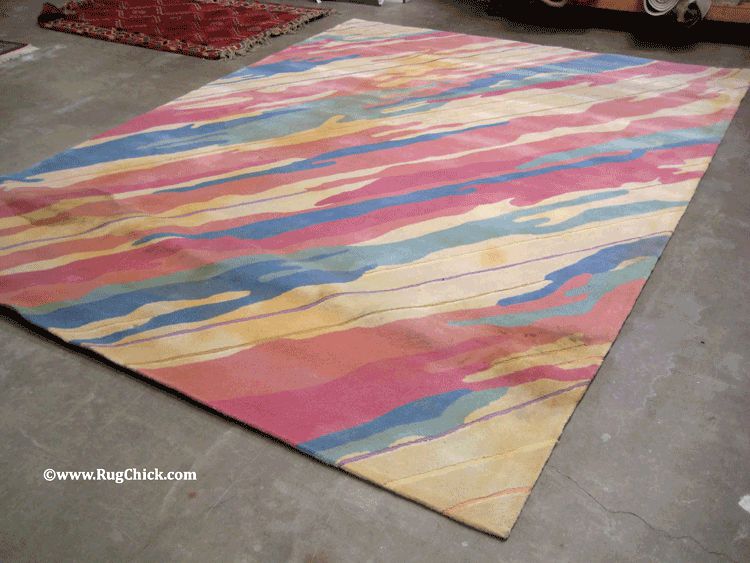
Tufted rug – flood contaminated.
Whether the tufted rug was a pet toilet, or was involved in a flood, it needs to be fully soaked to wash and decontaminate. But, with the earlier problems mentioned, the longer you soak these rugs the more problems you have.
It’s a catch 22.
You need to soak it to remove the odor causing contaminants, but soaking it can contribute to delamination, yellowing, water marks and discoloration on the backing material, and possible stencil ink bleeding.
What’s a rug cleaner to do?!?
Communicate all of the dangers, and the options, and have the rug owner tell you what they want done. Just be sure if you go ahead with the wash that you have a release of liability in case the “worst case scenarios” unfold during the soaking. The cleaner should not be punished for limitations created by poor rug construction.
ODOR THAT IS NOT COMING OUT
On some tufted rugs, the odor will not be coming out no matter how long you soak the rug.
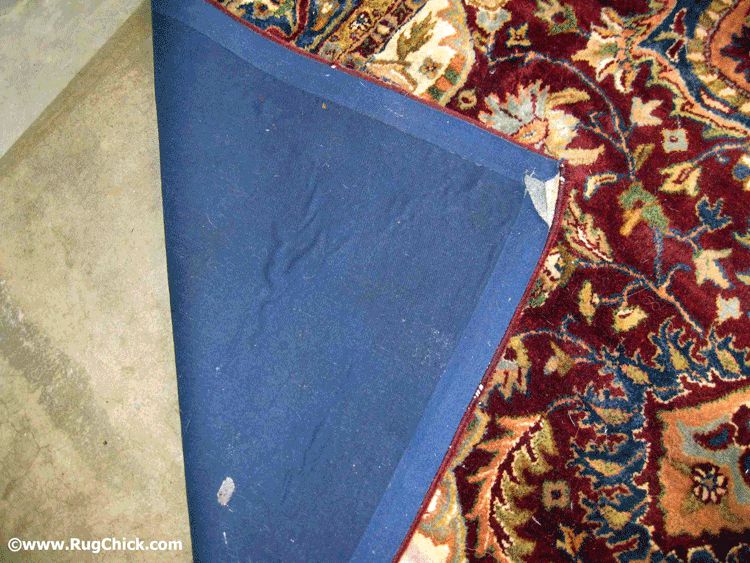
Tufted rug bad odor.
With a certain percentage of tufted rugs from India (including many of the problem India rugs being sold through Pottery Barn, at least in the San Diego area), the rugs have an awful odor present in brand new product.
The odor is a smell that is like a combination of burnt rubber and dirty sweaty socks. It’s rancid, and it gets WORSE with cleaning.
It appears to be situations where the latex has gone bad and soured, and they still use it anyway. This is a manufacturing flaw, and the rug should be returned for a problem-free one instead.
HOW TO HANDLE TUFTED RUGS:
If you own a tufted rug, and you’ve bought it from a reputable rug merchant, you will likely have no issues taking it to be professionally cleaned. Do not clean the rug yourself. These rugs take considerably longer to dry, and you open up yourself to a whole host of problems (and mess) if you try a D-I-Y clean.
These rugs also should never be cleaned in the home setting. Though there may be no warning signs on the rug itself, you open yourself up to potential damage to the floor underneath (yellowing, dye transfer, latex powder residue).
If you are a professional rug cleaner, these are the things you need to take into consideration, because today’s tufted rugs hold many more challenges than those from even a few years ago.
Your pre-wash inspection process needs to include front and back close evaluation, and grinning open the front tufts to look for stencil ink dangers. Give the back of the rug a whack and see if any powder POOFS out to the front, especially in areas where you see there have been spills on the rug. This will show you delamination dangers if you are unable to pull away the backing material to evaluate the strength of the latex.
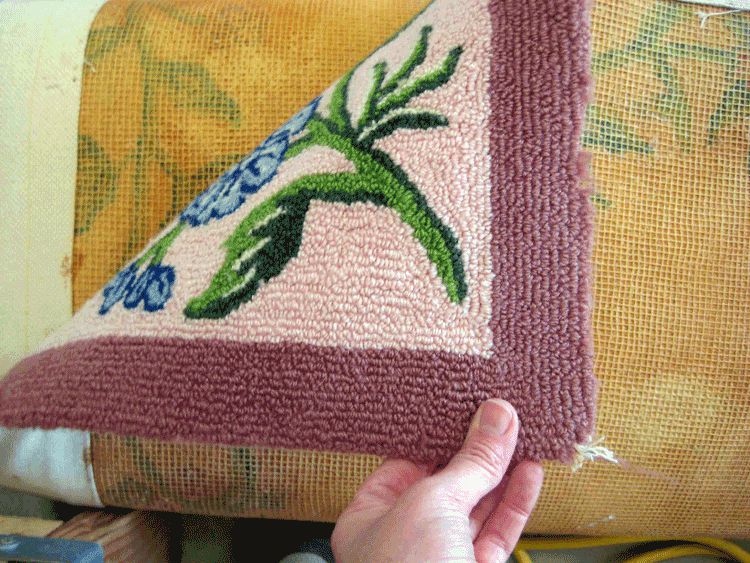
Tufted hooked rug. Latex back.
It is always best to communicate expectations BEFORE the wash. Share how the rug is constructed, and why it has material covering up the back, and that this will get blotchy after cleaning.
It is possible, when rugs delaminate, to re-latex the back and put a new material backing on the rug. This takes time and adds a significant repair cost to the cleaning. But if the rug has gotten heavily soiled, or contaminated by pets or a flood, it may be necessary to fully wash and then fully repair the rug in this way.
And the work may end up approaching what they paid to purchase their rug to begin with, so you might give them the opportunity to buy another rug instead. Especially if there is a chance that the odor in the rug won’t be coming out of that glue. Unfortunately some of these rugs end up being “disposable rugs” when they get contaminated badly with pet urine, because getting the odor out can be tough.
When corners get cut to produce a product that is cheaper for the buyer – someone ALWAYS ends up paying.
I just wanted to point out some of the dangers lurking in some of these tufted rugs so professional cleaners don’t end up being the ones who end up paying. =)
If you are thorough with your pre-inspection process, you will see the warning signs to keep you on safer ground.
Happy rug cleaning!
– Lisa
